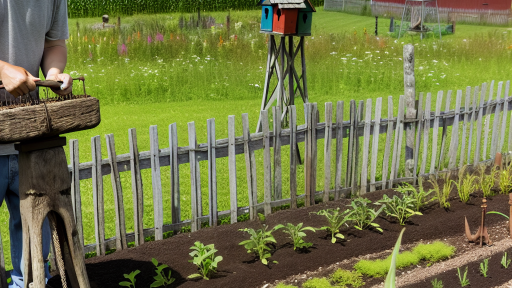Introduction to Crop Rotation and Its Importance in Sustainable Agriculture
Crop rotation is a vital practice in sustainable agriculture.
It involves alternating the types of crops grown in the same area over sequential seasons.
This method enhances soil health and reduces dependency on chemical fertilizers.
Additionally, crop rotation helps prevent pest and disease cycles.
Promoting Soil Fertility
One of the key benefits of crop rotation is improved soil fertility.
Different crops utilize different nutrients in the soil.
For example, legumes fix nitrogen, enriching the soil for subsequent crops.
This natural replenishment reduces the need for synthetic fertilizers.
Enhancing Biodiversity
Crop rotation fosters greater biodiversity in agricultural settings.
By planting diverse crops, farmers attract a wider range of beneficial insects.
This practice promotes a balanced ecosystem, bolstering natural pest control.
Reducing Soil Erosion
Another advantage of crop rotation is reduced soil erosion.
Planting various crops helps maintain soil structure and integrity.
Cover crops can protect soil during off-seasons, preventing nutrient loss.
Breaking Pest and Disease Cycles
Crop rotation effectively disrupts pest and disease cycles.
Transform Your Agribusiness
Unlock your farm's potential with expert advice tailored to your needs. Get actionable steps that drive real results.
Get StartedMany pests are specific to certain crops and struggle to survive when the host crop changes.
This practice reduces the reliance on chemical pesticides over time.
Increasing Yield Stability
Farmers experience more consistent yields with crop rotation.
By diversifying crops, farmers can mitigate the risks associated with market fluctuations.
This stability is essential for long-term success in agriculture.
Historical Perspectives on Crop Rotation Practices
Origins of Crop Rotation
Farmers have utilized crop rotation for centuries.
This practice promotes soil health and increases crop yields.
Evidence of crop rotation dates back to ancient civilizations.
For instance, ancient Egyptians practiced crop rotation along the Nile.
They alternated between wheat and barley to optimize soil fertility.
Development Through History
In the Middle Ages, European farmers advanced these techniques.
They implemented three-field systems to maximize land use.
This system involved rotating crops among three fields.
Each field was planted with a different crop each year.
These practices significantly improved agricultural yields.
Modern Advances in Crop Rotation
In the 18th century, agronomists began studying and promoting crop rotation.
Farmers like Charles Townshend introduced innovative practices in England.
His famous four-course system included turnips and clover in the rotation.
This increased nitrogen in the soil, enhancing crop growth.
Impact on Sustainable Agriculture
Today, crop rotation remains vital for sustainable agriculture.
This technique helps control pests and diseases effectively.
Moreover, it promotes soil organic matter and fertility.
Farmers today implement a variety of crops to maintain ecosystem diversity.
Consequently, crop rotation supports resilient agricultural systems.
Showcase Your Farming Business
Publish your professional farming services profile on our blog for a one-time fee of $200 and reach a dedicated audience of farmers and agribusiness owners.
Publish Your ProfileMechanisms of Crop Rotation
Improving Soil Structure
Crop rotation significantly enhances soil structure.
Different crops develop various root systems.
This diversity helps prevent soil compaction.
Loose soil supports better water infiltration.
Increased air spaces allow for healthier root growth.
Enhancing Nutrient Availability
Crop rotation boosts nutrient cycling within the soil.
Diverse plants utilize different nutrients.
Legumes, for example, fix nitrogen into the soil.
This enriches the soil and benefits subsequent crops.
As a result, farmers spend less on fertilizers.
Pest and Disease Management
Rotating crops helps break pest and disease cycles.
Many pests are crop-specific and thrive in monocultures.
Changing crops each season disrupts their life cycles.
This reduction minimizes the need for chemical treatments.
Consequently, farmers can grow healthier and more vigorous plants.
Promoting Biodiversity
Crop rotation encourages greater biodiversity on farms.
Increased plant variety supports diverse ecosystems.
Beneficial insects and microorganisms thrive in these habitats.
These organisms naturally contribute to pest control and soil health.
As a result, the entire agricultural system becomes more resilient.
Contributing to Sustainable Practices
Implementing crop rotation aligns with sustainable agriculture goals.
This practice conserves resources and promotes ecological balance.
It helps mitigate soil erosion and enhances carbon sequestration.
Farmers adopting this method can cultivate healthier ecosystems.
In essence, crop rotation is a cornerstone of sustainability.
Explore Further: Sustainable Agriculture: Benefits of Diverse Crop Rotation
Benefits of Crop Rotation in Pest and Disease Management
Enhancing Soil Health
Crop rotation improves soil structure and fertility.
This method reduces soil compaction and increases aeration.
Healthy soil supports diverse microbial life.
Moreover, diverse crops contribute different nutrients to the soil.
Diversifying Plant Families
Rotating crops prevents pest and disease buildup.
Different crops belong to various plant families.
Each family has unique vulnerabilities and resistance mechanisms.
By rotation, pests find fewer hosts to infest.
Disrupting Pest Life Cycles
Crop rotation interrupts pest life cycles effectively.
Changing crops between seasons confuses pests.
For instance, a pest that thrives on a specific crop will struggle after a rotation.
Consequently, this action decreases pest populations significantly.
Reducing Chemical Inputs
Employing crop rotation minimizes the need for pesticides.
Farmers rely on natural pest management strategies instead.
Showcase Your Farming Business
Publish your professional farming services profile on our blog for a one-time fee of $200 and reach a dedicated audience of farmers and agribusiness owners.
Publish Your ProfileThis practice promotes ecological balance on the farm.
Natural pest predators can thrive without chemical interference.
Improving Biodiversity
Crop rotation fosters greater agricultural biodiversity.
Biodiversity enhances ecosystem stability.
It encourages beneficial insects, which help control pests.
Additionally, diverse plant life strengthens resilience against diseases.
Real-World Applications
Successful crop rotation systems exist worldwide.
For example, a farmer in Illinois rotates corn and soybeans annually.
This approach has significantly reduced pest problems.
Likewise, a grower in Spain alternates between vegetables and legumes.
Such rotations improve soil health and yield quality.
Explore Further: Crop Rotation Strategies for Healthy Sustainable Farms
The Role of Crop Rotation in Enhancing Biodiversity on Farms
Understanding Crop Rotation
Farmers have utilized crop rotation for centuries.
This practice involves alternating the types of crops grown in a particular area.
By doing so, farmers can restore nutrients to the soil.
Moreover, they can disrupt pest and weed cycles effectively.
Benefits to Soil Health
Crop rotation enhances soil health significantly.
Diverse crops contribute to a balanced nutrient profile in the soil.
For instance, legumes fix nitrogen, improving soil fertility.
As a result, this reduces the need for chemical fertilizers.
Promoting Biodiversity
This agricultural method supports increased biodiversity on farms.
Diverse plant species attract various beneficial insects and wildlife.
Subsequently, this creates a more resilient ecosystem.
For example, planting cover crops can provide habitat for pollinators.
Reducing Pest Populations
Crop rotation naturally decreases pest populations.
Pests often thrive when the same crops are grown annually.
By changing crops, farmers can disrupt their life cycles.
Consequently, this leads to lower pesticide use over time.
Improving Resilience to Disease
Diverse cropping systems enhance disease resistance.
Different crops have varying vulnerabilities to specific pathogens.
Consequently, rotating crops minimizes the risk of widespread disease outbreaks.
This practice strengthens the overall health of the farm ecosystem.
Supporting Climate Adaptation
Crop rotation also aids in adapting to climate change.
It improves soil structure and water retention.
As a result, this makes farms more resilient during extreme weather events.
Farmers can therefore sustain production levels despite environmental challenges.
See Related Content: Eco-Friendly Waste Reduction Methods for Farms

Economic Advantages of Implementing Crop Rotation Systems
Improved Soil Health
Crop rotation enhances soil health significantly.
Different crops contribute unique nutrients to the soil.
This practice reduces soil erosion and increases fertility.
Showcase Your Farming Business
Publish your professional farming services profile on our blog for a one-time fee of $200 and reach a dedicated audience of farmers and agribusiness owners.
Publish Your ProfileFurthermore, it decreases reliance on chemical fertilizers.
Increased Crop Yields
Farmers often see higher yields with crop rotation.
This method allows for better pest management.
Moreover, rotating crops can boost overall crop resilience.
It’s evident that diverse cropping leads to greater productivity.
Cost-Effectiveness
Implementing crop rotation can lower production costs.
Farmers can save money on pesticides and fertilizers.
Additionally, reducing pest populations leads to fewer losses.
This strategy ultimately enhances profit margins for farmers.
Market Advantages
Diversified crops can attract niche markets.
Farmers can grow specialty crops that are in high demand.
Having multiple crops reduces market risk.
This flexibility allows farmers to adapt to market changes swiftly.
Long-Term Sustainability
Crop rotation promotes sustainable agricultural practices.
This approach supports biodiversity and ecosystem health.
Furthermore, it helps farmers prepare for climate variability.
By investing in this practice, farmers contribute to the health of future generations.
Learn More: Sustainable Recycling Practices in Agriculture
Challenges and Limitations of Crop Rotation in Modern Farming
Adoption Barriers
Farmers often hesitate to implement crop rotation due to perceived complexity.
Many believe that traditional practices are easier and more predictable.
Furthermore, some may lack adequate training on rotation strategies.
This reluctance limits the effectiveness of sustainable agriculture.
Resource Requirements
Implementing crop rotation can require significant resources.
Farmers must invest in planning and managing diverse crops.
Additionally, equipment and labor costs may increase with rotation practices.
Consequently, smaller farms may struggle to adopt these methods.
Changing Market Demands
Market preferences can impact crop rotation decisions.
Some crops may not yield sufficient profit in certain regions.
As a result, farmers may prioritize cash crops over rotation benefits.
This challenge can derail sustainable practices in farming.
Pest and Weed Pressure
Crop rotation does not eliminate all pest and weed issues.
Pests can adapt quickly, diminishing rotation effectiveness.
Additionally, some weed species may thrive regardless of crop type.
This ongoing pressure requires continual management efforts.
Soil Requirements
Different crops have varying soil needs, complicating rotations.
Certain crops may deplete essential nutrients from the soil.
Consequently, farmers must monitor soil health closely throughout rotations.
This can lead to unexpected additional costs and planning requirements.
Knowledge Gaps
Successful crop rotation demands a solid understanding of agronomy.
Farmers may find themselves lacking necessary knowledge and resources.
Showcase Your Farming Business
Publish your professional farming services profile on our blog for a one-time fee of $200 and reach a dedicated audience of farmers and agribusiness owners.
Publish Your ProfileThis knowledge gap can result in ineffective rotation systems.
Ultimately, this diminishes the potential benefits of crop rotation.
Case Studies: Successful Crop Rotation Strategies in Different Regions
Northern California’s Diverse Farming
Northern California employs an innovative crop rotation approach.
Farmers here alternate between tomatoes, broccoli, and lettuce.
This strategy enhances soil fertility and reduces pests.
For example, the Anderson Family Farms has seen notable yield increases.
They achieved a 20% rise in tomato production over three years.
The Midwest Corn and Soybean Rotation
The Midwest utilizes a classic corn-soybean rotation system.
This practice effectively controls weed growth and enhances soil structure.
Several farmers reported lower fertilizer costs after adopting this rotation.
The Johnson Brothers’ farm has thrived under this rotation strategy.
They have improved their profit margins significantly over recent years.
Organic Farming in the Southeast
In the Southeast, organic farmers embrace complex rotations.
They rotate crops like cotton, peanuts, and cover crops.
This method improves long-term soil health and moisture retention.
GreenLeaf Organics has documented considerable positive outcomes.
They note that crop diversity has led to robust soil microbiomes.
Australia’s Adaptive Rotation Methods
Australian farmers implement adaptive rotation strategies.
Common rotations involve wheat and pulses, such as chickpeas.
These practices enhance resilience against drought conditions.
Farmer Sarah Thompson has successfully reduced water usage by 30%.
Her adaptability showcases the benefits of intelligent crop selection.
Community Efforts in Brazil
In Brazil, local cooperatives emphasize sustainable rotation practices.
They rotate sugarcane, soy, and beans to improve nutrition in soil.
This initiative also combats erosion and enhances biodiversity.
Cooperative leader Marco Silva shares the community’s progress.
They report increased community awareness and participation in sustainable practices.
Additional Resources
Integrated decision support for promoting crop rotation based …




